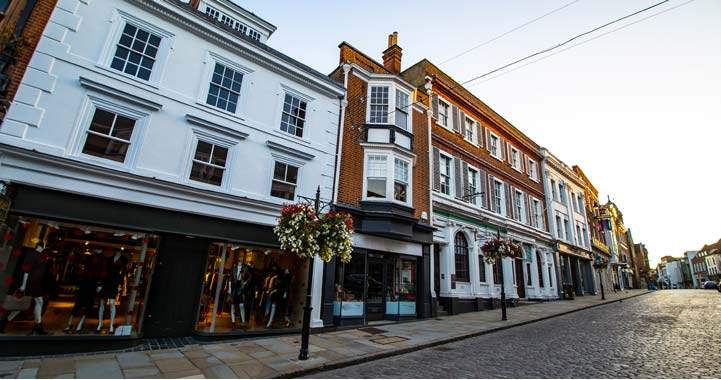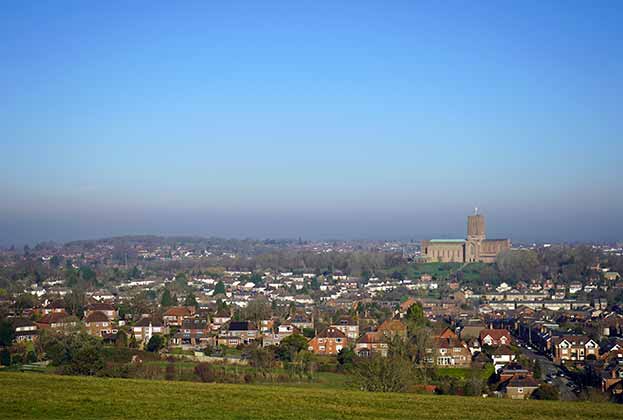What’s happened over the past 10 years in the county town of Guildford?
Over the past 10 years, Guildford has seen strong growth in both the commercial and residential sectors. It has become a creative and tech powerhouse, delivering economic output at a rate well ahead of other comparable towns. However, the strong growth since 2009 is now starting to create problems of affordability, which will be exacerbated if the area continues to struggle to deliver enough new homes to meet local need.

Driving commercial growth
A major contributor to Guildford’s success story in recent years has been the University of Surrey. It is a leader in the fields of scientific and technological research, with a strong reputation in health, medicine, space, environment and mobile communications.
Working in tandem with local businesses, it owns and operates the Surrey Research Park, encompassing 700,000 sq. ft. of office, research and development space, home to over 140 companies. Occupiers are limited to research, development and design activities in any science, including social science that is complementary to the activities of the University. This ensures that the 70-acre site remains focused on knowledge based-industries that support the commercial application of the University’s research.
The research park is set to be extended with an extra 325,000 sq. ft. of space planned, as part of the Blackwell Farm urban extension over the next Local Plan period. This should help Guildford to continue to prosper in these fields, with local industries and the University itself working together to support growth.
One sector that has benefited from this approach is the gaming industry. The University claims Guildford is home to the largest cluster of video gaming companies in the UK, with over 60 studios and more than 1,000 employees in the industry. What’s more, this is a hugely successful and growing industry. Across the UK, the gaming market was worth £3.9bn in 2018 according to the Entertainment Retailers Association (ERA), more than double the amount in 2007. This makes it a larger market than both the film and music industry combined.
Guildford’s gaming community was further strengthened recently when Electronic Arts committed their future to the town by consolidating Onslow House and expanding to lease a further 22,000 sq. ft. in 2019.
Motorsport also dominates the area with McLaren taking space in Woking town centre in addition to their HQ on the outskirts of the town and Mercedes-Benz located in Weybridge.
The commercial market
Guildford is an established office market, along with Woking, which caters for both small and large occupiers, both in out of town and town centre locations. Large corporate occupiers have been attracted in recent years which is reflected in the five-year average take-up totalling 88,000 sq. ft.
The town centre market has benefitted from new office development. Beltane Asset Management have recently developed 42,000 sq. ft. at 255 High Street, and M&G Real Estate comprehensively refurbished London Square which has achieved a rent of £34 per sq. ft., a 34% increase from 2009 prime rental levels. Despite ongoing political uncertainty, confidence in the market remains strong; Investra are speculatively developing 30,000 sq. ft. at Riverworks which is set to achieve practical completion later this year.
Increasingly, however, there is a risk of occupiers being drawn away from the town, as the focus for tech and R&D moves to the Oxford-Cambridge corridor. There have been several corporate relocations from Guildford since 2018 including Ericsson and Sanofi both moving to Reading. This highlights the importance of continuing to provide high-quality commercial space that meets occupier’s needs, and maintaining the strong links between the university and the development of commercial space for these occupiers.
We expect further rental growth across Guildford. The good levels of occupier demand combined with the strong rental growth has resulted in strong investor interest for office assets when they become available. This was highlighted by the consistent institutional investor demand for assets in the market, since 2009 who have accounted for 54% of total office investment into Guildford.
Housebuilding
Whilst commercially, Guildford and its wider area has had some success over the past 10 years, the level of residential development has not kept pace with the town’s need.
Over the past 10 years, Guildford has averaged 250 Net Additional Dwellings per year. Its Local Plan, adopted in April 2019, but currently going through the judicial review process, has a target of at least 562 Net Additional Dwellings per annum, whilst the need defined by the MHCLG standard calculation is 789 per year. At the same time, Guildford has delivered substantially fewer affordable homes.
The wider area including the local authorities of Woking, Elmbridge, Surrey Heath and Runnymede have an Objectively Assessed Need of over 2,600 homes per annum, whilst the MHCLG standard calculation that takes into account housing affordability is higher at 2,719. For context, over the past decade, 1,165 homes have been delivered each year on average across the five authorities. A lack of supply is therefore being felt across the wider region, not just Guildford itself.
Pricing, transactions and affordability
Over the long term, a lack of new housing supply will have knock-on consequences. These are arguably already being felt. Since the previous 2008 peak, Guildford and its surrounding local authorities combined have seen values rise by 40%, going from £390,000 in 2008 to £550,000 in 2018. Values across the South East region have risen by 35% in the same period.
Transactions across the wider Guildford area are also just a few percentage points above the low of 2009. From 2009 to 2013, transactions rose 27%, compared to 24% in the South East. Since then, however, with squeezed affordability and lack of stock on the market, Guildford has fallen further away, with transactions now just 3% above the low of 2009. The equivalent figure for the South East is 21%. Furthermore, the new build market accounts for just 8% across the wider Guildford area compared to 13% across the South East.
Affordability pressures are also being keenly felt. The ratio of median house prices to median workplace earnings across the region are well ahead of the national average of 8.1. Since 2009 these have increased at different rates with Woking and Elmbridge rising 24% and 30% respectively, whilst Surrey Heath has increased by 62%. Elmbridge however still remains the most unaffordable market with house prices 15.7 times that of earnings. Guildford itself has risen by 50% going from 8.35 in 2009 to 12.53 in 2018.
The potential consequences
It is little surprise to see a correlation between those local authorities where affordability ratios have worsened the most and those that have built the fewest homes. The lack of supply in Guildford is feeding into further affordability pressures, as illustrated.
This poses a threat to continuing economic growth if employees are priced out of the area; businesses could find it harder to recruit or retain staff, ultimately making this location a less attractive area for commercial occupiers.
The knock-on impact of people commuting from more affordable locations such as Hampshire to the south puts increased pressure on traffic and infrastructure, with resulting commuter pinch points.
Read the articles within Guildford: Driving Surrey below.


.jpg)
